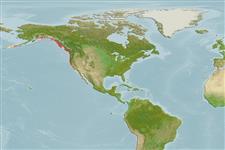Common names from other countries
Environment: milieu / climate zone / depth range / distribution range
Ecologia
marino demersale; distribuzione batimetrica 20 - 80 m (Ref. 51666). Temperate
Eastern Pacific: Aleutian Islands, Alaska to San Miguel Island, southern California, USA.
Size / Peso / Age
Maturity: Lm ? range ? - ? cm
Max length : 15.0 cm TL maschio/sesso non determinato; (Ref. 2850)
Short description
Chiavi di identificazione | Morfologia | Morfometria
Spine dorsali (totale) : 53 - 55; Raggi dorsali molli (totale) : 0; Spine anali: 1; Raggi anali molli: 37 - 42. Caudal rounded (Ref. 6885). Color variable- males brownish, sometimes with a red tinge; pale spots rimmed with darker on sides of body; spots fainter, smaller, and more numerous dorsally on sides; light on lower part of head with several brown streaks; white on pelvic fins and anterior part of anal fin; other fins with brown pigment spots in bands forming faint bars. Females nearly plain brown on body; in line spread along middle of dorsal fin about 13 dark spots each surrounded by a clear area to form prominent ocelli (Ref. 6885).
Usually in intertidal and subtidal rocky areas (Ref. 2850, 51666). Sometimes hides in crevices and tubeworms holes with only head protruding (Ref. 2850).
Life cycle and mating behavior
Maturities | Riproduzione | Spawnings | Egg(s) | Fecundities | Larve
Eschmeyer, W.N., E.S. Herald and H. Hammann, 1983. A field guide to Pacific coast fishes of North America. Boston (MA, USA): Houghton Mifflin Company. xii+336 p. (Ref. 2850)
IUCN Red List Status (Ref. 130435)
CITES (Ref. 128078)
Not Evaluated
Threat to humans
Harmless
Human uses
Pesca: commerciale; Acquario: Commerciale
Strumenti
Special reports
Download XML
Fonti Internet
Estimates based on models
Preferred temperature (Ref.
115969): 4.9 - 11.6, mean 7.9 (based on 39 cells).
Phylogenetic diversity index (Ref.
82804): PD
50 = 0.5039 [Uniqueness, from 0.5 = low to 2.0 = high].
Bayesian length-weight: a=0.00372 (0.00147 - 0.00941), b=3.17 (2.95 - 3.39), in cm Total Length, based on LWR estimates for this (Sub)family-body shape (Ref.
93245).
Trophic level (Ref.
69278): 3.6 ±0.50 se; based on food items.
Resilienza (Ref.
120179): Medio, tempo minimo di raddoppiamento della popolazione 1.4 - 4.4 anni (Preliminary K or Fecundity.).
Fishing Vulnerability (Ref.
59153): Low vulnerability (10 of 100).
